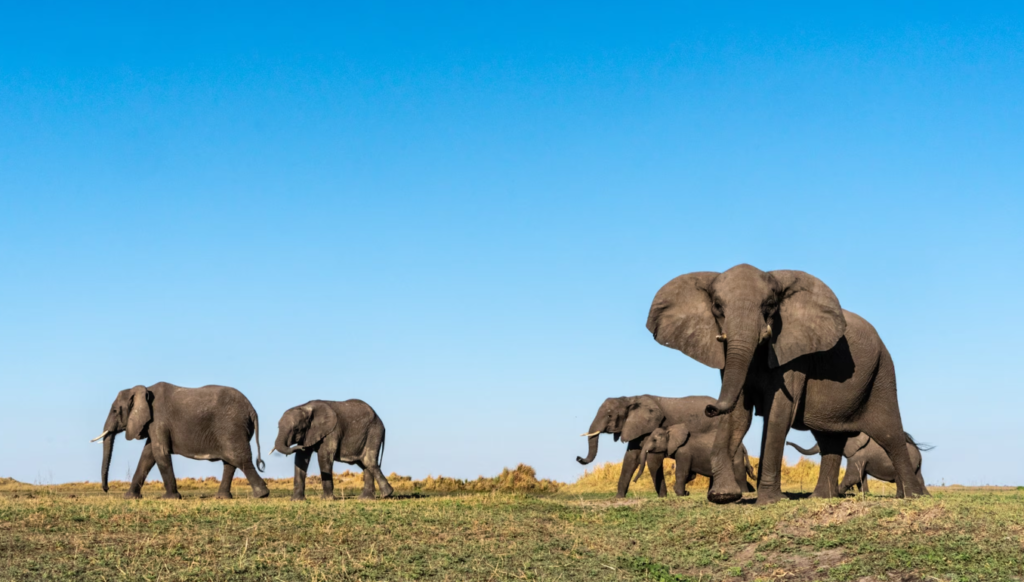
Since she started studying African savanna elephants in 1975, biologist Joyce Poole noticed that sometimes an elephant would call out to their kin. Sometimes, a bunch would answer, and other times only one would respond.
“I suspected elephants had a way of directing their calls to specific individuals,” says Poole, scientific director and co-founder of the nonprofit ElephantVoices, but “had no idea how one would tease this out.”
Now, scientists have published new research in the journal Nature Ecology and Evolution that begins to do just that. The study provides evidence that elephants address each other with calls, or names, that are specific to the individual.
Names are a rare phenomenon in the animal kingdom, and the few species that use them, such as parrots and dolphins, mimic a sound first made by the recipient. Bottlenose dolphins, for example, broadcast their own signature whistle, which others repeat when addressing them.
Elephants seem to do something different: They use arbitrary vocal labels that have nothing to do with sounds or physical properties of the listener.
“We thought this was unique to people,” says study co-author George Wittemyer, a biology professor at Colorado State University and and chairperson of Save the Elephants’ scientific board.
In human language, an arbitrary label would be calling a bovine a “cow,” since that word does not resemble, either physically or acoustically, the animal itself. A simpler label, which scientists call an iconic label, would refer to a bovine as a “moo,” since that’s based on and imitates sound the animal makes.
Arbitrary labels expand the scope for communication and provide a way of expressing abstract thought—and it’s likely true for elephants, too. “In terms of cognition, that opens all sorts of possibilities,” Wittmyer says.
What’s in a name?
The team drew on both recordings made from 2019 to 2022 in Kenya’s Samburu National Reserve and Buffalo Springs National Reserve, as well as archival recordings from Amboseli National Park in the 1980s, 1990s, and 2000s. Poole, a study co-author and National Geographic Explorer, made the Amboseli recordings.
In all, the team analyzed data from 101 African savanna elephants making 469 separate calls to 117 recipients.
The scientists focused on contact, greeting, and caregiving rumbles, which elephants use when initiating contact with an unseen family member, approaching another in touching distance, and nurturing a calf. These were the types of calls researchers thought were most likely to contain a name.
Elephants produce a range of vocalizations, from trumpets and barks to many types of rumbles. Their structures are complicated. For example, rumbles are low-frequency sounds, partially outside the range of human hearing, that not only vary a lot but can travel through the ground and last anywhere from half a second to 12 seconds. That diversity can contain a lot of information, which makes them challenging to interpret.
“Our data suggest that, unlike human names, where the name itself accounts for most of the variation in the utterance, elephant names account for only a small portion of the variation in the call,” says study leader Mickey Pardo, a Colorado State University postdoctoral fellow.
“Elephants may cram more information into a single vocalization, so the name might be only one piece of a complex signal that simultaneously conveys other information.”
Though researchers don’t know how a name is encoded in a call, this study indicates it is there.
Plugging the data into a computer algorithm, researchers found that calls from the same caller to the same receiver were more similar than calls from the same caller to different receivers.
Hence, the acoustic structure of calls from a Samburu elephant named Frida to a matriarch, Donatella, were more alike than Frida’s calls to other elephants, like her cousin Rothko.
This “indicates that the calls were indeed specific to the individual targeted receiver,” Pardo says.
